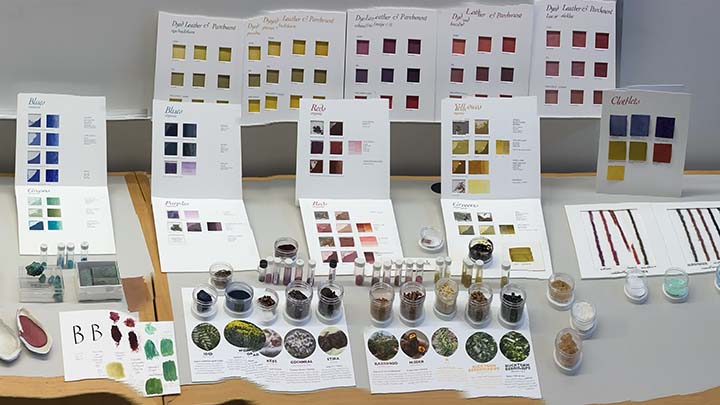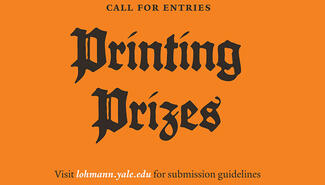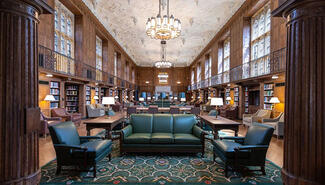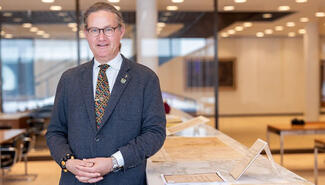Hands-on learning: Three student curators explore color in theory and practice
“Color is something we tend to take for granted,” says Whitney Toutenhoofd ’25, a double major in Art and Humanities, “so it was fascinating to look more critically at its perceptual and conceptual properties and applications.” Toutenhoofd is one of the three student curators of the new exhibition Matters of Color/Color Matters, now on view in Sterling Memorial Library’s exhibition corridor. The exhibition grew out of the students’ enthusiasm for a seminar by the same name, offered in the Department of the History of Art in fall 2021.
Cynthia Roman, curator of Prints, Drawings, and Paintings at Yale’s Lewis Walpole Library, and Jae Rossman, fellowship program director at Beinecke Rare Book and Manuscript Library, were the course designers and instructors. “The experience of teaching with objects has been important to both of us throughout our careers,” Rossman says, so the two decided to teach a class together. They chose the topic color, a longstanding shared interest, as the learning lens.
Learning through collections
Students in the class examined an array of special collections materials—scientific texts, decorative arts objects, photographs—to explore the history of color in theory and application. “The most important part of the class,” Rossman explains, “was that there were two sides of the same coin: students learning that there are objects at Yale that they can interact with and then learning how to do that.”

To provide students with a close look at artwork and objects, classes were held at Beinecke Rare Book and Manuscript Library, Haas Family Arts Library, Yale Center for British Art, Yale University Art Gallery, and Cushing/Whitney Medical Library. The group also made a field trip to Lewis Walpole Library in Farmington and to the nearby Hill-Stead Museum.
“Our earliest class sessions were especially successful,” Rossman says. The group went to Yale Art Gallery to study the work of the Impressionist painters and Post-Impressionist artists Paul Cézanne and Vincent van Gogh.“We chose these works because students would already be familiar with them. We then were able to introduce the book about color theory written by Michel Eugène Chevreul in 1839, which the Impressionists would have been familiar with and thinking about when they made their works. It was a great way to begin the conversation about how art and science are so closely linked.”
The science of color
The class also provided students with lots of hands-on experience and real-world insights. They learned, for example, about the ways in which the discovery of lightfast chemical dyes in the 1800s changed the fashion industry. “We presented a different way of looking at familiar things,” Rossman says, “tying them together with a through line of color.”
The instructors made the subject of conservation central to the course from the beginning. Library and museum conservators hosted student visits to their departments, and some came to class sessions as guest speakers. Theresa Fairbanks-Harris, senior paper conservator at Yale Center for British Art and Yale Art Gallery, taught students to make pastels, draw with them, and hand-color prints.

In another hands-on learning module, library conservators Marie-France Lemay and Laura O’Brien-Miller helped students put together a kit to grow the bright bluish-green pigment verdigris on copper. The students later harvested the verdigris, ground it to powder, and made green paint.
During their visit to the Medical Historical Library, students examined a fifteenth-century herbal, in which green leaves were colored with verdigris. Centuries later, the paint was corroding the pages of the book. O’Brien-Miller and Melissa Grafe, head of the library, who were partners in the preservation of the book, explained to students the work they were doing to ensure the important object would be available for future study.

The two instructors purposefully designed the course as a first-year seminar. “We wanted it to be an introduction to the library’s special collections and resources, the museums, and the amazing conservators, curators, and librarians at Yale,” Roman explains. “We know how critical the work of our colleagues in the library is,” Rossman adds.“They are a valuable resource for students, and students should know about these resources as soon as possible in their academic careers.”
Knowledge on display
The idea for the exhibition Matters of Color/Color Matters grew out of the serious interest of three sophomores—Toutenhoofd, Liam Hannigan, and Jennifer Le—in the professions of art history, curating, and conservation. Their enthusiasm inspired Roman and Rossman to encourage the students to apply to the Student Research at Yale Library exhibit program to learn more.
Once accepted, the students worked closely with Roman and Rossman and also with Kerri Sancomb, exhibits production manager, and Sarah Davis, library exhibits technician, to design and install the exhibition. “Creating this exhibition allowed me to delve deeply into the field of curatorial work,” says Hannigan, who is now interested in pursuing a career in museum work. “It was brilliant to have the opportunity to apply the knowledge learned in class in a practical way.”
The three student curators will discuss their project and answer questions at the opening reception of the exhibition on Nov. 30 at 4:30 p.m. Among the colorful facsimile objects on display are the fifteenth-century verdigris-colored herbal, Isaac Newton’s color wheel, a color-coded sixteenth-century chart for calculating lunar nodes, and former Yale Professor of Art Josef Albers’s influential book Interaction of Color. “We covered a lot of content during the class,” Le says, “so it is really gratifying to step back and see all our hard work as one cohesive piece of work.”
“Making use of Yale Library’s extensive special collections throughout the class and then while creating this exhibition was a really exciting opportunity,” Toutenhoofd says. “The student-curator program is such an amazing resource, which I would recommend all students take advantage of.”
The exhibition Matters of Color/Color Matters is on view in the Sterling Memorial Library Exhibition Corridor through April 23, 2023.
—Deborah Cannarella
Photos by Jae Rossman



